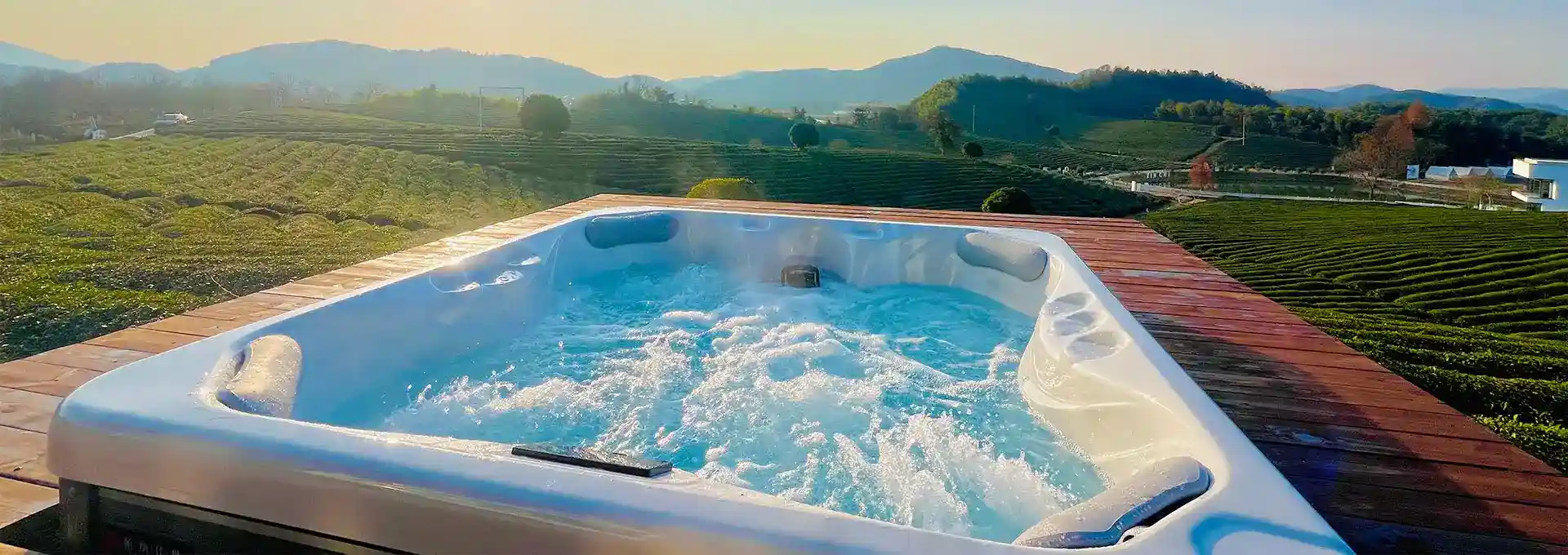Does Homeowners Insurance Cover Hot Tub?
2024-08-14 17:36:00
Homeowners insurance is designed to protect your property and belongings from various risks, but when it comes to hot tubs, coverage can be a bit murky. Many homeowners wonder whether their standard policy extends to these luxurious additions. The answer isn't always straightforward and depends on several factors, including your specific policy, the circumstances of any damage or liability, and how the hot tub is classified within your property. Let's dive into the details of hot tub coverage under homeowners insurance and explore some common questions that arise when considering insurance for your 4-person outdoor hot tub.
What are the best 4-person outdoor hot tubs for year-round use?
When searching for the perfect 4-person outdoor hot tub for year-round use, several factors come into play. Durability, energy efficiency, and features tailored for all-season enjoyment are crucial considerations. Top-rated models often include well-insulated shells, powerful jet systems, and advanced water purification technologies.
The Bullfrog Spas A6L is frequently cited as a premium choice for year-round use. Its JetPak Therapy System allows for customizable massage options, while its energy-efficient design helps maintain water temperature even in colder months. The sturdy acrylic shell and full-foam insulation contribute to its ability to withstand various weather conditions.
Another popular option is the Hot Spring Highlife Aria. This model boasts excellent energy efficiency with its FiberCor insulation and custom-fitted covers. Its No-Fault heater ensures consistent water temperature, making it ideal for use in any season. The Aria also features the Moto-Massage DX jet, providing a moving hydromassage experience that many users find superior for relaxation.
For those seeking a more budget-friendly option without sacrificing quality, the Essential Hot Tubs SS125210003 Devotion-24-Jet Hot Tub is worth considering. Despite its lower price point, it offers robust features such as multi-layered fiberglass reinforcement, full foam insulation, and a heavy-duty tapered cover. These elements contribute to its year-round usability, even in harsh weather conditions.
When selecting a 4-person outdoor hot tub for all-season use, it's essential to consider the climate in your area. Models with enhanced insulation and powerful heaters are particularly important in regions with cold winters. Additionally, look for tubs with durable covers that can withstand snow loads and prevent heat loss.
Maintenance features are another crucial aspect of year-round hot tubs. Many high-end models come with advanced filtration systems and ozonators that reduce the need for chemical treatments and make water care easier throughout the year. Some even offer smart system controls that allow you to monitor and adjust settings remotely, ensuring your hot tub is always ready for use, regardless of the season.
Lastly, consider the placement of your hot tub. While these models are designed for outdoor use, providing some shelter, such as a gazebo or pergola, can enhance the year-round experience and potentially extend the life of your hot tub by protecting it from direct exposure to harsh elements.
How much does it cost to run a 4-person hot tub monthly?
The cost of running a 4-person hot tub can vary significantly based on several factors, including energy efficiency, usage patterns, local utility rates, and climate conditions. However, understanding the average costs and the factors that influence them can help you budget appropriately for your hot tub enjoyment.
On average, the monthly operating cost for a 4-person hot tub ranges from $20 to $120. This estimate includes electricity for heating and running pumps, water and chemical costs, and basic maintenance. Let's break down these costs in more detail:
Electricity: This is typically the largest ongoing expense for hot tub owners. The amount of electricity used depends on the tub's size, insulation quality, and how often you use it. Modern, energy-efficient models with good insulation can cost as little as $10 to $20 per month to heat, while older or less efficient models might run $50 or more. Climate plays a significant role here; colder regions require more energy to maintain water temperature.
Water and Chemicals: The cost of filling your hot tub and maintaining proper chemical balance is relatively low compared to electricity. Expect to spend about $10 to $20 per month on chemicals and perhaps an additional $5 to $10 on water, depending on your local water rates and how often you need to drain and refill the tub.
Maintenance: Regular maintenance is crucial for keeping your 4-person outdoor hot tub in good condition and can help prevent costly repairs. Budget about $10 to $20 per month for routine maintenance tasks such as filter cleaning or replacement and occasional professional servicing.
To minimize running costs, consider the following tips:
1. Invest in an energy-efficient model: Modern hot tubs with high-quality insulation and efficient heating systems can significantly reduce energy consumption.
2. Use a well-fitting, insulated cover: A good cover can prevent heat loss when the tub isn't in use, reducing heating costs.
3. Lower the temperature when not in use: Even a few degrees can make a difference in energy consumption.
4. Maintain your hot tub regularly: Proper maintenance keeps your tub running efficiently and can prevent costly repairs.
5. Consider your climate: In colder regions, you might want to invest in additional insulation or a model specifically designed for colder climates.
6. Take advantage of off-peak electricity rates: If your utility company offers lower rates during off-peak hours, consider heating your tub during these times.
7. Use a timer: Set your hot tub to heat only during times when you're most likely to use it.
8. Optimize jet usage: Running jets constantly increases energy consumption. Use them only when needed for hydrotherapy.
It's worth noting that while the monthly costs may seem significant, many hot tub owners find the benefits of relaxation, stress relief, and potential health improvements well worth the investment. Additionally, having a hot tub at home can reduce expenses on spa visits or other forms of entertainment and relaxation.
When budgeting for a hot tub, also consider the initial purchase and installation costs, which can range from $3,000 to $15,000 or more for a 4-person outdoor hot tub, depending on the features and quality. Factor in potential increases in your homeowners insurance premium as well, as adding a hot tub to your property may affect your coverage needs.
Are inflatable hot tubs worth it compared to traditional models?
The debate between inflatable hot tubs and traditional hard-shell models is ongoing, with each option offering distinct advantages and drawbacks. To determine if inflatable hot tubs are worth it, we need to consider various factors including cost, durability, performance, and convenience.
Cost: One of the most significant advantages of inflatable hot tubs is their lower initial cost. While a traditional 4-person hot tub can cost anywhere from $3,000 to $15,000 or more, inflatable models typically range from $300 to $1,000. This substantial price difference makes hot tub ownership accessible to a broader range of consumers. However, it's important to consider long-term costs as well. Inflatable 4-person outdoor hot tubs may have higher operating costs due to less efficient insulation and may need replacement sooner than traditional models.
Durability: Traditional hard-shell hot tubs are generally more durable and have a longer lifespan, often lasting 10-20 years or more with proper maintenance. Inflatable hot tubs, while made from sturdy materials, typically last 2-5 years. They are more susceptible to punctures, tears, and wear from repeated inflation and deflation. However, many users find that with careful use and proper storage, they can extend the life of their inflatable hot tub significantly.
Performance: When it comes to performance, traditional hot tubs generally have the edge. They offer more powerful jets, better temperature control, and superior insulation, which translates to a more consistent and enjoyable experience, especially in colder weather. Inflatable hot tubs usually have fewer and less powerful jets, and their heating systems may struggle to maintain temperature in cold conditions. However, for casual use or in milder climates, many users find the performance of inflatable tubs satisfactory.
Convenience: Inflatable hot tubs excel in terms of convenience and flexibility. They can be easily set up, taken down, and stored when not in use, making them ideal for renters or those with limited space. This portability also allows for repositioning in your yard or even taking the hot tub on trips. Traditional hot tubs, once installed, are permanent fixtures that require dedicated space.
Energy Efficiency: Due to their construction, traditional hot tubs are generally more energy-efficient. Their solid shells and superior insulation help maintain water temperature with less energy input. Inflatable models, with their thinner walls and less robust covers, often require more energy to keep the water warm, potentially leading to higher electricity bills.
Maintenance: Both types require regular maintenance, but inflatable hot tubs may need more frequent attention. Their softer surfaces can be more prone to algae growth, and the water may need more frequent chemical treatments. However, the simplicity of inflatable models can make some maintenance tasks easier for DIY-inclined owners.
Features: Traditional 4-person outdoor hot tubs often come with a wider range of features such as built-in lighting, advanced jet systems, and integrated sound systems. While some higher-end inflatable models are beginning to offer similar features, they generally lag behind in this area.
Aesthetics: For those concerned with the visual appeal of their outdoor space, traditional hot tubs typically offer a more luxurious and permanent look. Inflatable models, while improving in design, may not enhance the aesthetics of a backyard to the same degree.
Resale Value: Traditional hot tubs, especially well-maintained high-end models, can add value to a home. Inflatable hot tubs, being portable, don't offer this benefit but also don't commit future homeowners to a permanent installation.
In conclusion, whether an inflatable hot tub is "worth it" depends on individual circumstances and priorities. For those seeking a low-cost entry into hot tub ownership, valuing portability, or dealing with space constraints, inflatable models can be an excellent choice. They offer a way to enjoy the relaxation and social benefits of a hot tub without a significant financial commitment or permanent installation.
However, for users prioritizing performance, longevity, energy efficiency, and a wider range of features, traditional hard-shell hot tubs may be the better investment. They offer a superior experience, especially in colder climates or for frequent, year-round use.
Ultimately, both options have their place in the market. Inflatable 4-person outdoor hot tubs have made hot tub ownership accessible to a broader audience and can serve as an excellent introduction to the world of hydrotherapy. They're particularly suitable for occasional use, warmer climates, or as a temporary solution. Traditional hot tubs, while requiring a larger upfront investment, offer a more robust, feature-rich experience that many find worth the additional cost over time.
If you want to get more information about this product, you can contact us at info@iparnassus.com!
References:
1. Insurance Information Institute. (2023). Homeowners Insurance: What's Covered.
2. Consumer Reports. (2024). Hot Tub Buying Guide.
3. Energy.gov. (2023). Energy-Efficient Hot Tubs and Spas.
4. HomeAdvisor. (2024). How Much Does a Hot Tub Cost?
5. Bullfrog Spas. (2024). Hot Tub Energy Efficiency Guide.
6. Hot Spring Spas. (2024). Hot Tub Maintenance 101.
7. Aqua Magazine. (2023). The Pros and Cons of Inflatable Hot Tubs.
8. SpaDepot. (2024). Hot Tub Chemistry 101.
9. This Old House. (2023). How to Choose the Right Hot Tub.
10. Better Homes & Gardens. (2024). Everything You Need to Know About Hot Tubs.



